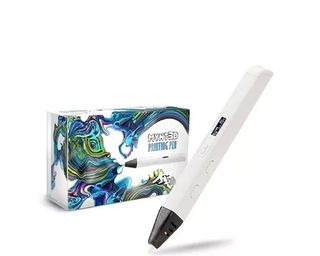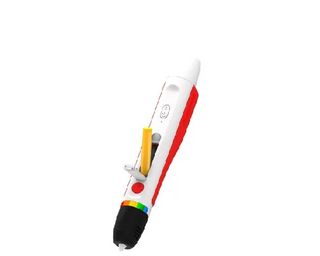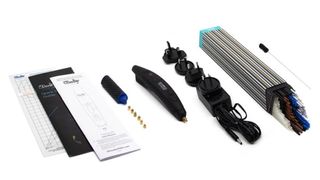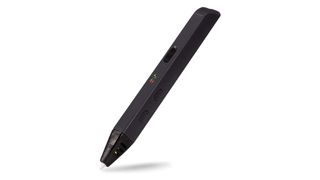The best 3D pens: model and design in 3D
Create three-dimensional art in an easy and intuitive way, with the best 3D pens for adults and children.

The best 3D pens allow you to sculpt in 3D using a range of materials, most commonly plastics. And while they're popular amongst kids, they're seriously art tools for adults too. For example, if you work in architecture, creating a quick 3D model can be a quick way to solve issues in your designs.
To curate this list of the best 3D pens available today, I've researched and rated a host of available options, considering factors like price, design and functionality. I've also used drawn on my personal experience of using 3D pens, as well as in-depth reviews on this and our sister websites.
In a world dominated by digital design, 3D pens offer a great way to get hands-on in crafting real-world, physical products with very little outlay. If you want to go further with analogue design, also see our roundup of the best laser cutters and our list of the best 3D printers.
The quick list
The super-flexible device is our pick as the best 3D pen overall. It's lightweight and ergonomic, with a comfy grip making it easy to hold, and it enables you to adjust the filament's speed and flow for optimal control of the process.
Read more
Here's our top pick for beginners. This 3D pen has a beautifully ergonomic design and is super easy to use, even for first-timers.
It has great support for newcomers, including online resources and it comes with a handy guidebook too.
Read more
As the name suggests, this is a top choice for pros. This stylish and feature-packed pen can not only draw with ABS materials but also metal, wood, and copper, and features a number of advanced features, including a variable dial.
Read more
Cheaper than number 1 on this list, this 3D pen has the same gearbox and replaceable nozzle design, but without an OLED display or temperature controls. If you don't need these, that makes it excellent value overall.
Read more
Designed for children aged 6+, this 3D pen features no hot parts, and the controls are kept to a minimum, making it easy to use. We think this is a great beginner pen, not only for kids but adults new to 3D pens too.
Read more
If you're looking for something fun to do on a rainy day then the Polaroid CandyPlay 3D Pen is an excellent choice for kids and adults with a sweet tooth. Quite simply it enables you to create sweets and sugar art using 3D pen tech.
Read more
The best 3D pens in full
Why you can trust Creative Bloq
Best 3D pen overall
01. MYNT3D Pro 3D Printing Pen
Specifications
Reasons to buy
Reasons to avoid
Lightweight and ergonomic, the MYNT3D Pro is easy to hold and use. The modular nozzle design is easy to replace, so mistakes won't put it out of action. And experienced hands will appreciate its sophisticated features. All this makes it, in my eyes, the best 3D pen on sale today.
You can adjust the speed and flow of the plastic filament for finer control. You can also make fine tweaks to its temperature, in one-degree increments. And there's even a OLED display to monitor this, too. Plus it's super-flexible. Unlike many other 3D pens, the MYNT3D Pro supports a range of filament types: not just ABS and PLA, but according to the makers MYNT3D, any thermoplastic. "If it is 1.75mm and melts between 140-230° C, then it will work in the MYNT3D Pen", it claims. That could mean, for example, filaments infused with wood or bronze.
The pen is USB powered, so you can do some 3D drawing while you're away from a wall socket, by hooking it up to a plug adapter, laptop or one of the best power banks, as long as they have at least 2A output. The only downside is that it's quite expensive, and probably overkill for beginners and kids, but it does represent the best overall 3D pen by features and price.
Best 3D pen for beginners
Specifications
Reasons to buy
Reasons to avoid
Never used a 3D pen before? Then we recommend the 3Doodler Create+. It has a beautifully ergonomic design that's easy to use, even for first-timers. More experienced hands will enjoy using this too, with dual speed and temperature controls giving you a nice degree of control.
This pen supports FLEXY plastics as well as PLA and ABS, although be aware they must be 3Doodler ones, which tend to be on the pricey side. You get 50 filaments included with this package, in a variety of colours, as well as a comprehensive guidebook. In our 3Doodler Create+ review we noted how this 3D pen comes with everything you need to get started.
While the initial price seems high for a beginner 3D pen, the fact you get so many filaments, a guidebook and tools for getting started make this a good option if you've never used one of these crafty tools before. Once you get started you can upgrade to the 3Doodler PRO+ below, which takes the same brand's tech and steps it up a level.
Best pro 3D pen
03. 3Doodler PRO+
Specifications
Reasons to buy
Reasons to avoid
The 3Doodler PRO+ is one of the few 3D pens aimed at artists and professional crafters. It can make use of a number of filament types other pens on my list can't offer, including wood, copper and bronze materials.
This 3D pen offers a little more control over the flow temperature and flow rate to others on my list. The 3Doodler PRO+ features a variable fan speed control to handle how and when materials cool and harden, which is essential for complex sculptures and artworks. The pen itself is beautifully finished in carbon fibre and comes with an LCD display to monitor your settings. Overall this feels a step above other 3D pens. It would be No.1, but it's probably overkill for most people. Its intended audience, though, will love it.
If you're an artist or work in architecture, engineering and design, the 3Doodler PRO+ would be a good addition to your studio. It's a step up from other 3D pens so takes a little longer to grasp and get used to, but the results are fantastic.
Best value 3D pen
04. MYNT3D Super 3D Pen
Specifications
Reasons to buy
Reasons to avoid
Watching the pennies? Then check out the MYNT3D Super 3D Pen, which represents excellent value. It's similar to the Pro model (No.1 on my list), with the same gearbox and replaceable nozzle design. And yet at time of press, it was a lot cheaper.
There's a reason for that, of course. Here, you don't get the OLED display, or the temperature adjustment feature. Instead, a temperature adjustment screw lets you switch between the correct temperatures for ABS and PLA, but you're limited to those two materials.
However, it's still a great 3D pen and represents excellent value, which is easy to use in practice. Plus you get a stylus, three colours of ABS plastic and a 100-240V AC 50 / 60Hz adapter in the box. So overall, this 3D pen is excellent value.
Best 3D pen for kids
05. 3Doodler Start+ Essentials
Specifications
Reasons to buy
Reasons to avoid
The 3Doodler Essentials Start+ is my clear choice as the best 3D pen for children. Adhering to strict safety standards, it's designed with no hot parts, which means the pen nozzle and plastic can be touched without risk of burning. That makes it a safe choice for kids aged six and upwards.
It's also easy for kids to use, as the controls have been kept purposely simple. As with all 3Doodler pens, you can only use the company's own range of filaments, but you do get 72 strands to get you going, in eight colours (this is more than you used to get a year or so ago). Each strand offers 60 inches' worth of 3D printing, so that will get you pretty far before you need to buy more.
3Doodler has a good reputation in the 3D pen market, and this one has been designed for kids, and the brand has a good supply of fun filaments themed around 'fire and ice', 'stars and stripes' and more; so a lot of fun to be had.
Best 3D pen for sugar craft
06. Polaroid CandyPlay 3D Pen
Specifications
Reasons to buy
Reasons to avoid
Here's a new and fun use of 3D pen tech from Polaroid (which used to make a lot of 3D pens but has gradually cut back). The Polaroid CandyPlay 3D Pen is designed to craft candy designs, from sweets to cake toppings, but also for complex sugar craft creations. If you've watched Bake Off or Is It Cake and want to test your food art skills, this is a neat gadget.
It works by heating up the supplied sugar-free candy cartridges (you get 48 with the 3D pen and replacement packs can be bought from Polaroid and Amazon) and then slowly building candy-sculptures as you would with a traditional 3D pen using plastics.
Naturally there are some drawbacks, for one being a candy-powered device it can get sticky and the nozzle and innards are prone to gluing up - so regular cleaning it a must. Sugar heats at a higher temperature to the filaments of standard 3D pens, so you it can take a while to reach the consistency needed, find for adults but kids could get impatient. Regardless, the Polaroid CandyPlay 3D Pen is a fun, novel and artsy use of 3D pen tech.
FAQs
Do 3D pens really work?
Yes, 3D pens really work, if what you want to do is create a 3D model by hand. If you want to create a 3D model based on a pre-existing design, though, you need a 3D printer.
A 3D pen uses the same type of heating element to melt filament that you get in a 3D printer. But while the latter is controlled by software, a 3D pen you control entirely yourself, much like using a glue gun, so you can get truly expressive. Once the filament leaves the filter, it cools rapidly, and hardens into whatever shape you have formed it into.
What is a 3D pen used for?
You can use a 3D pen to draw on any flat surface. But, as the name suggests, the real beauty of a 3D pen is that it allows you to draw in mid-air, using plastic filament, and create three-dimensional structures that then solidify. Alternatively, you can draw over an existing object to enhance it.
Who uses 3D pens?
Anyone can use a 3D pen, but they're commonly used by hobbyists, artists, makers, fashion designers and home furnishing designers in creative projects. They're also used by engineers and DIYers to solve practical problems, by teachers in education, and by kids for fun projects.
What 3D pen should I buy?
The best 3D pen available today is the MYNT3D 3D Pen Pro. It's light and ergonomically designed, making it easy to hold and use, whether you're a newbie or an experienced hand. An adjustable feed helps you stay in control, and you can increase the temperature in increments. It's USB powered and you can use a wide range of filaments.
What's the best 3D pen for beginners?
In our view, the best 3D pen for beginners is the 3Doodler Create+, because it's so easy to use. Just plug in the pen, insert your plastic, wait for it to heat up, then you can doodle in three dimensions. The extruded heated plastic hardens almost instantly, so you can draw 3D structures, freehand or on stencils. This 3D pen comes with different colours of plastics, which are all safe and non-toxic, and an activity guide book to get you started.
Are 3D pens environmentally damaging?
If you want to avoid harming the environment with your 3D pen, then the plastic we recommend using is PLA, which is short for Poly Lactic Acid. A polyester derived from renewable biomass, typically from fermented plant starch such as corn, cassava, sugarcane or sugar beet pulp, this type of plastic is both biogradable and sustainable. To be specific, it typically takes around six to 12 months to break down, while for most plastics it takes hundreds of years.
The other type of plastic commonly used in 3D pens, ABS, is not so great for the environment. Short for Acrylonitrile butadiene styrene, ABS is petroleum-based and non-biodegradable. It's both bad for the environment and more toxic to humans than PLA.
How to choose the best 3D pen
The first thing to consider when buying a 3D pen is the price. Most 3D pens come in below $100 / £100, with good entry-level 3D pens costing around $45 / £40. Some pro grade 3D pens like the 3Doodler PRO+, designed for complex art or Archviz, can go as high as $200 / £200.
It's worth considering what you need, as a 3D pen around $50 / £50 will be good quality for perfect for most projects. (The 3Doodler PRO+ has advanced features like a powerful, adjustable fan and can use wood and metal materials that not everyone needs.)
Beyond that, here are a number of other factors to take into account:
- Comfort I've selected 3D pens in my list that have a modern ergonomic design, with the heat nozzle protected from the handle. Also consider the size and weight of the 3D pen, I've included these measurements in my reviews above for each entry.
- Constant plastic flow To make the best models you need a solid, steady plastic extrusion flow which comes from consistent heating.
- Controls The 3D pens on my list all offer a degree of control over the flow of plastic, and the more you pay generally the better the control options. Simple 3D pens will have a Start / Stop but the better ones on my list will enable real time temperature changes as well, ensuring more detail in your models.
- Reliability Good 3D pens these days are made to be easily cleaned, some on my list come with detachable nozzles, for example. This is something to look for, as an easy-clean pen will last you longer and filament lines will be more consistent.
- Replaceable nozzles Some of the best 3D pens offer replaceable, interchangable nozzles; not only for cleaning but for adjusting the size of the filament to switch from broad 'filler' lines to build a model to thinner detail lines.
- Wide mix of filaments Ideally you want a 3D pen that can work with any filament on the market regardless of brand, but some, particularly those aimed at kids for safety, will require you to use a brand's particular filament. Most 3D pens on my list can use any filament, but one or two are locked into a brand's preferred type.
- Widely compatible filament: Most 3D pens are compatible with lots of different brands of filament, but some require uniquely designed plastic that has special features, or locks you into buying from the same company. A 3D pen that can work with a range of materials and brands is better.
How we test the best 3D pens
Where possible I like to get hands-on and test a 3D pen myself. I own an old Polaroid 3D pen (a present) and love it. I've used our own reviews where possible, as well as referencing reviews from 3D World magazine; a title with over 20 years experience in all things 3D. If we've not reviewed a particular model because it's new or hard to source I've referenced experts online, on YouTube and from our sister tech websites, TechRadar and Tom's Guide.
Get the Creative Bloq Newsletter
Daily design news, reviews, how-tos and more, as picked by the editors.
Ian Dean is Editor, Digital Arts & 3D at Creative Bloq, and the former editor of many leading magazines. These titles included ImagineFX, 3D World and video game titles Play and Official PlayStation Magazine. Ian launched Xbox magazine X360 and edited PlayStation World. For Creative Bloq, Ian combines his experiences to bring the latest news on digital art, VFX and video games and tech, and in his spare time he doodles in Procreate, ArtRage, and Rebelle while finding time to play Xbox and PS5.
















